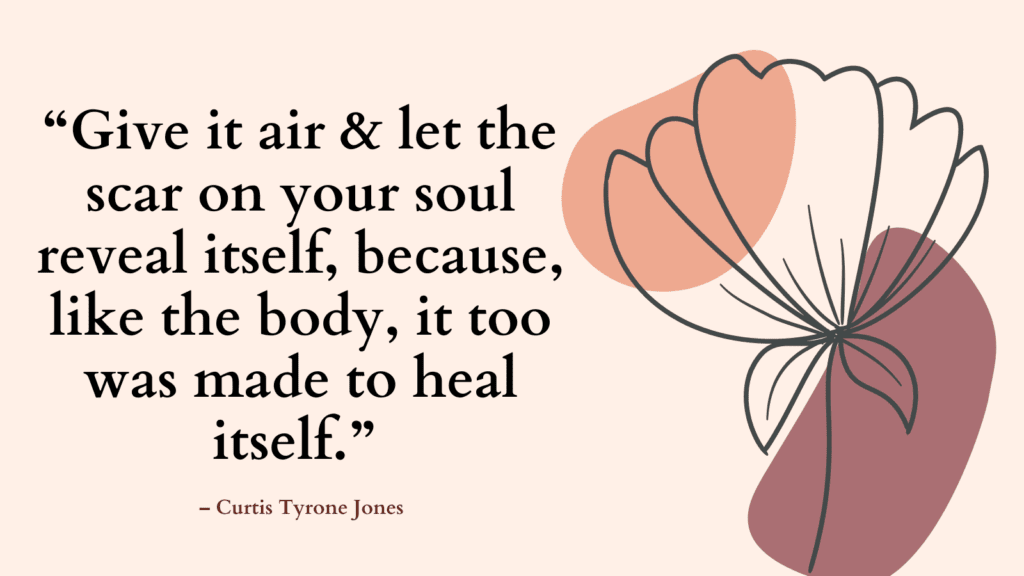This post contains high functioning anxiety test along with tips and strategies to support your anxiety recovery.
- What Is High Functioning Anxiety?
- High Functioning Anxiety Test
- How to Support Your Anxiety Recovery?
- Anxiety vs Anxiousness – what’s the difference?
- How We Develop Anxiety Disorders?
- Anxiety Treatment: MBCT, CBT, and ERP
- How To Beat Anxiety Without Medication?
- Mindfulness-Based Cognitive Therapy (MBCT)
- Behavioral Therapy (CBT)
- FREE Thought Log Worksheet PDF Download
- Exposure and Response Prevention (ERP)
- Free Printable Worksheets For Anxiety (PDF)
- FAQ
What Is High Functioning Anxiety?
High-functioning anxiety refers to someone who experiences excessive anxiety while still managing to excel at work and in their personal life.
High-functioning anxiety is not a diagnosis that is recognized by the Diagnostic and Statistical Manual of Mental Disorders (DSM-5).
People who struggle with perfectionism and/or people-pleasing often experience high functioning anxiety.
Although people with high-functioning anxiety appear put together on the outside, they are internally struggling with excessive worry and stress.
Related: Top 10 Practical CBT Exercises For Generalized Anxiety Disorder Relief
High Functioning Anxiety Test
The following questions represent common symptoms of high functioning anxiety:
Results
#1. Do you tend to worry overanalyze excessively?
#2. Do you often ruminate or experience intrusive thoughts of “What if…?”
#3. Do you struggle with fear of failure and always push yourself toward perfection?
#4. Do you experience insomnia or physical fatigue?
#5. Do you constantly worry you may let people down and find it difficult to say no?
#6. Do you tend to dwell on past mistakes?
#7. Do you always expect the worst?
#8. Do you have a difficulty expressing emotions?
#9. Do you tend to procrastinate?
#10. Do you have nervous habits (e.g. biting your nails, playing with your hair, cracking knuckles, biting your lip)?
We will not sell your information. All results are kept confidential.
This quiz is for informational purposes only. It is not meant as a diagnostic or assessment tool.
Results
The questions above represent common signs of high functioning anxiety. If you answered yes to most of these questions, then high functioning anxiety may be a problem for you.
Related: What Is the 333 Rule for Anxiety? (& Other Anxiety Coping Strategies)
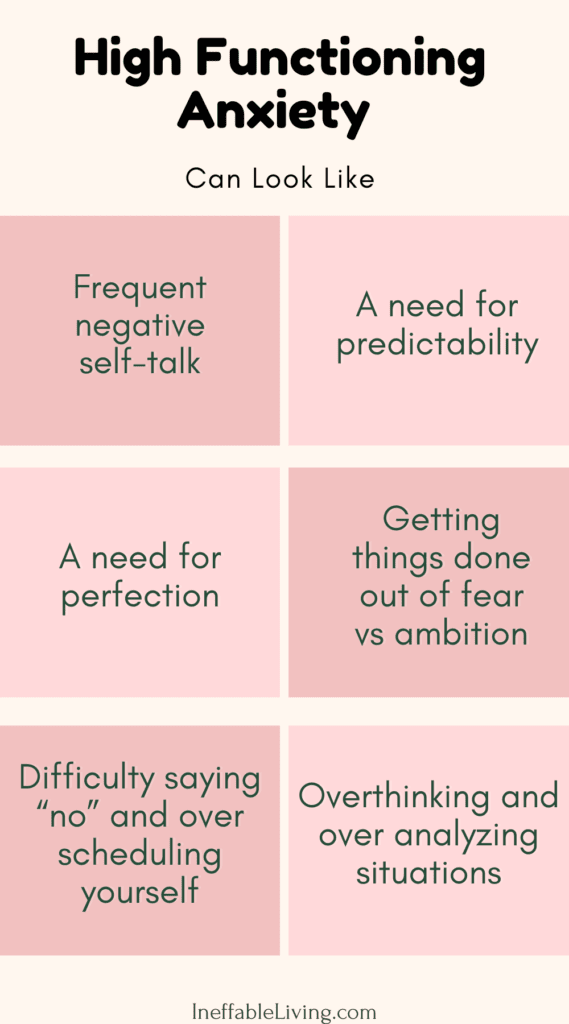
How to Support Your Anxiety Recovery?
If you are struggling with anxiety and anxiousness, you are not alone.
According to the Anxiety and Depression Association of America (ADAA) one out of every five people has trouble with anxiety ranging from generalized to situation-specific. (1)
Related: Anxiety Free Resources
Anxiety vs Anxiousness – what’s the difference?
Is Anxiety And Feeling Anxious The Same Thing?
‘Anxiety’ and ‘anxiousness’ are often used interchangeably. Although there are certain similarities in symptoms, they differ in strength and persistence.
Anxiety is an umbrella term that covers anxiety disorders, which are; Generalized Anxiety Disorder (GAD), Social Anxiety Disorder, Obsessive Compulsive Disorder (OCD), Panic Disorder, Specific Phobia, and Post-Traumatic Stress Disorder (PTSD).
Anxiety is persistent and is not necessarily a response to a particular experience.
Anxiousness, on the other hand, is a natural response to a particular event, such as a job interview, or meeting someone for the first time.
This response tends to naturally decrease once the event comes to an end and in general over time as we expose ourselves to these situations more often.
Whether you’re struggling with anxiety or anxiousness, the following strategies and exercises will help reduce your symptoms and bring immediate relief.
Related: How To Stop Self-Critical Thoughts Using These Top 10 Techniques
How We Develop Anxiety Disorders?
1. Excessive Worrying
Just like all our other behaviors, we worry because we think it will benefit us.
Worrying serves a purpose: it helps us prepare for or prevent danger. For example, worrying about our health helps us make changes in our diet and lifestyle.
However, when that worrying becomes excessive and irrational, it becomes unproductive.
This is especially true when our valuations are unrealistic – we over- or undervalue one of the factors in worrying.
Related: Half-Smiling Technique to Reduce Emotional Distress
2. Panic
Our amygdala (responsible for processing fearful and threatening stimuli) tells our body to produce adrenaline when we encounter a stressor.
This adrenaline gives our muscles and organs a boost in energy and causes all of the anxious symptoms associated with adrenaline, such as rapid heart rate, shallow breathing, dilated pupils, etc.
The amygdala dials down its response over time, and our body releases excess adrenaline.
However, when we consciously worry about the anxious symptoms we’re experiencing, this causes more adrenaline production, which leads to a panic attack.
In practice, it looks like this:
1. You experience an anxious symptom like elevated heart rate.
2. Your mind creates a suggestive thought about that symptom, like “Am I having a heart attack?”
3. You begin to worry about that thought and consider your options, “What if my heart fails?” or, “Will I need to call an ambulance?”
4. This worrying signals to the amygdala that you are in danger, causing it to produce even more adrenaline. This intensifies the symptoms, creates a loop, and brings you back to step one.
Related: Agoraphobia Natural Treatment: 9 Steps to Overcome Panic Attacks
Anxiety Treatment: MBCT, CBT, and ERP
Some of the main therapies used in treating anxiety include:
1. Mindfulness-Based Cognitive Therapy (MBCT)
MBCT helps in reducing anxious symptoms and panic attacks.
Panic happens when we worry about an anxious symptom.
MBCT helps us stop the loop by changing our response to suggestive thoughts about our anxious symptoms and choosing not to worry about them, cutting off the release of more adrenaline.
In practice, the initial symptoms will show up, but instead of intensifying and turning into panic, they will remain at the same level and then slowly go down. As you practice more, the anxious symptoms will appear less often and will be less intense.
Related: 6 Simple Ways to Practice Mindfulness Throughout The Day (and Find Your Inner Peace)
2. Cognitive Behavioral Therapy (CBT)
CBT helps you challenge suggestive thoughts so you can see exactly what thoughts are unrealistic, and enables you to adopt new helpful ones.
In the long term, CBT helps reduce our unhealthy valuations and reduce excessive worrying, which in turn, helps reduce adrenaline production and anxious symptoms.
3. Exposure and Response Prevention (ERP)
ERP targets the amygdala (responsible for processing fearful and threatening stimuli) using exposure to fearful situations. This induces positive experiences for the amygdala so that it desensitizes and changes its response to some situations.
However, no matter how often we expose ourselves to a stressor, the amygdala will still count the experience as negative if we panic.
This is why ERP is only effective when we couple it with a therapy that prevents panic and ensure every exposure ends positively, like MBCT.
In short, MBCT targets short-term panic, CBT addresses long-term worrying, and ERP helps reduce the strength of anxious symptoms.
An ideal approach would be using just MBCT for a few weeks. Then, add CBT and once you are used to practicing both, you can add ERP.

How To Beat Anxiety Without Medication?
Mindfulness-Based Cognitive Therapy (MBCT)
Techniques such as deep breathing and progressive muscle relaxation, while can offer relief, it doesn’t stop us from worrying.
MBCT teaches you how to experience anxious symptoms without worrying about them, allowing the body to release all of the leftover adrenaline without making more.
When we change our behavior (worrying), our anxious thoughts will out and slowly go away.
How Can You Stop Worrying?
By minimizing the benefits and maximizing the costs of worrying in your head, so you can choose not to worry about the suggestive thoughts arising.
The MBCT method consists of four steps: recognize, respond, return, and remind.
Step 1. Identify Your Anxious Thoughts
When a suggestive thought about an anxious symptom arises, begin by identifying that thought.
Identifying here means spelling out the exact thought you are having about your anxious symptom.
While this might seem obvious to people who have practiced doing so in therapy or while meditating, for people who have been worrying for most of their lives, it feels like they are worrying about nothing.
Start by asking yourself, “What am I worrying about right now?”
You might be worrying about having a heart attack, or fainting, or going crazy.
Be specific about your anxious thought.
Step 2. Respond to Your Anxious Thoughts
Once you have identified the thought you are worrying about, you can respond to it in a way that helps you decide not to worry.
It’s easier to come to that decision when you can see that the costs outweigh the benefits of worrying and that you don’t really need to worry.
Start by examining your history with anxious symptoms.
Despite having panic attacks in the past, you never had a heart attack, stopped breathing, or went crazy.
Examining your past experiences with panic can help you realize that anxious symptoms are harmless and that you don’t need to worry about them.
It’s also important to consider the costs of worrying.
Worrying about your anxious symptoms has not actually protected you from danger, quite the opposite – it made you even more anxious.
Respond to your anxious thoughts in a helpful way.
You can tell yourself something like, “Whatever. I know I’ll be fine,” or, “Let it be. I felt this way a hundred times before. I know this will also pass.”
Step 3. Distract Yourself From Self-Checking
Once you have responded to the anxious thought, you need to avoid checking whether the original symptom has gone away.
One way to distract yourself from self-checking is to return your attention to the task at hand, or focus on something that grabs your attention and shuts down the urge to check-in.
If you are having a conversation with someone, recall the last thing they said.
If we are not in the middle of anything, choose an engaging activity, such as solving a problem, writing, or playing an instrument.
Step 4. Remind Yourself Why You Do Not Need to Worry
When you bring your attention back to the present moment, your anxious symptoms will begin to fade away.
However, some small suggestive thoughts might arise. The final step here is to answer small thoughts without having to repeat the first three steps.
Say to yourself something like, “Whatever. I don’t care,” and go back to the task at hand.
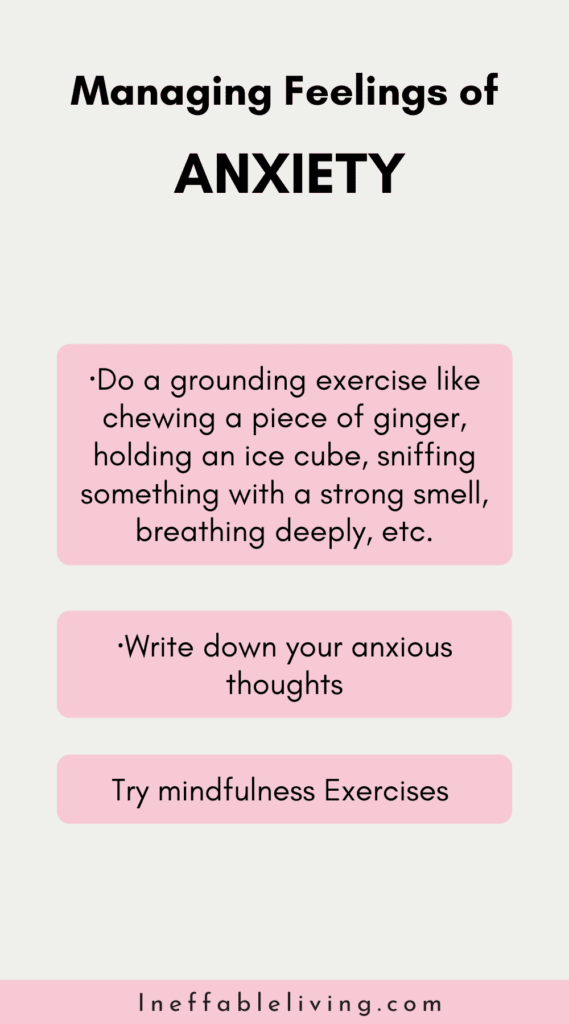
Behavioral Therapy (CBT)
Worrying is not always unhelpful. Worrying about life choices and decisions can be helpful and lead us to act productively.
CBT can help you identify what worrying is helpful and what is unhelpful.
How to differentiate between healthy and unhealthy worrying?
Healthy worrying is when you spend no more than a few minutes considering an issue and that consideration leads to taking meaningful action. For example, briefly worrying about money can lead you to start saving and budgeting.
But when we constantly worry about the same issue without taking action or solving a problem, worrying becomes unhealthy.
1. Identify Anxious Thoughts
Just like MBCT, we begin by identifying what we are worrying about.
Ask yourself “What am I worrying about?” and be specific.
2. Identify The Valuation Behind The Anxious Thought
Once you identified the anxious thought, ask yourself, “Why am I worrying about this?”
3. Examine The Logic In Your Valuation
In this step, you’re looking for cognitive distortions.
Cognition is a fancy word for thought – the way we interpret everything happening around us.
Sometimes our thoughts become distorted. We might think in ways that are illogical that don’t reflect reality.
Ask yourself the following question, “How many times have you worried about something that didn’t end up happening, but you keep worrying about it each time?“
Related: When Your Brain Lies to You: How to Stop Cognitive Distortions and Overcome Depression?
Once you can identify the distortion in your way of thinking, you can challenge your old valuation and think of a more realistic thought.
Since it is more complex than MBCT, CBT is best practiced using a journal or a workbook.
Unhelpful Thinking Styles: Examples of Cognitive Distortions
The following are some common cognitive distortions:
1. Black-and-White Thinking
Black-and-white thinking means assuming that all situations have only two outcomes: good or bad.
Life is too complex to be thought of in such simplistic terms. For example, we cannot say eating food is good or facing a challenge is bad.
To correct this distortion, you can think to yourself, “Feeling uncomfortable is not the end of the world. I can still tolerate that feeling while doing what I need to do.”
2. Catastrophizing
Catastrophizing means overvaluing the worst-case scenario.
For example, if you’re having a test, catastrophizing would mean worrying about what would happen if you fail.
Catastrophizing is problematic because these worst-case scenarios almost never happen. So focusing on it is unrealistic.
It’s important to remind yourself of the in-betweens. The outcome might be bad, but it’s almost never as horrible as you expect.
3. Jumping to Conclusions
Jumping to conclusions means assuming something is true without evidence.
For example, you might assume that someone is angry with you based on her tone of voice.
Ask yourself, “Is it possible I’m not the reason she is acting this way?” and consider evidence to the contrary. Her initiating conversations can be a sign that she’s happy to talk to you.
4. Filtering
Filtering means discounting the positive and valuing only the negative. We might also filter out our positive experiences but not others’.
For example, spending so much time on social media can lead us to feel less attractive and see others as so much more attractive than us, ignoring the fact that people are posting their best pictures, which often are edited and filtered.
5. Overgeneralization
Overgeneralization is when you assume that one event is part of a larger trend when it is not.
For example, you might encounter a setback after weeks or months of behaving healthily, leading you to mistakenly take it as a sign that you are losing all of your progress.
Remind yourself that now that you’ve been practicing for a while, getting back on track will be much easier than when you first started.
6. Emotional Reasoning
Emotional reasoning is when we use our emotions to justify our actions.
For example, we might wake up feeling depressed and decide to stay in bed, even though we have things we need to do.
Using our emotions to make decisions is illogical because emotions come and go, sometimes, out of our control. You can feel sad and still do the things you need to do. You can feel angry, but decide not to act on it.
Related: Best 21 Evening Journal Prompts To Help You Relax & Unwind
FREE Thought Log Worksheet PDF Download
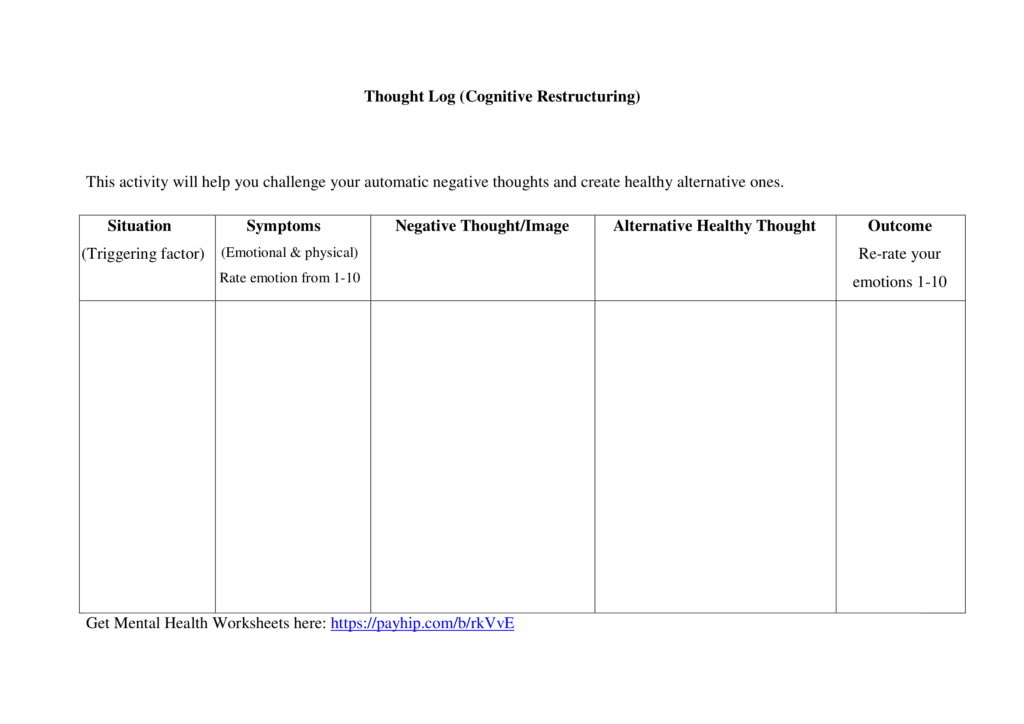
Exposure and Response Prevention (ERP)
Two main reasons our amygdala produces adrenaline are conscious worrying and unconscious threat detection due to the amygdala’s own internal programming.
This internal programming is based on experiences. When we have an experience that ends in discomfort, the amygdala dials up its response. This is why making our experiences more positive can help reduce the intensity of our anxious symptoms.
The purpose of ERP is to expose our amygdala to a stressor that activates it, then desensitize our amygdala by preventing ourselves from engaging in a negative response.
Rules of ERP
1. We need to expose ourselves to a stressor for longer than we are used to (at least ten or fifteen minutes after the most intense symptoms have passed).
2. Exposure needs to be gradual, starting with the least feared situations, then increasing the frequency, time, or volume of exposure and working our way up to the most feared ones as we get more comfortable.
3. To help our amygdala retain these experiences, we need to expose ourselves constantly and over time.
4. Exposure works best when we have plenty of experience practicing MBCT and CBT so we do not worry.
1. Direct ERP
Direct ERP is when we expose our amygdala to its stressors directly.
For example, if socializing at work causes you anxiety, direct ERP means regularly attending work functions, making small talk, and then extending the conversation gradually, all while using MBCT to prevent panic.
The more you expose yourself to these situations, the more your amygdala’s response weakens, and over time anxious symptoms will hardly come up at all.
2. Indirect ERP
Indirect ERP is when you expose yourself to a similar but less intense situation than the one that activates your anxiety.
This is especially useful when the feared situation is not accessible to practice frequently, like airplane flights or group presentations.
The goal here is to stimulate a similar sensation in an activity that is more accessible. For example, for those who fear air flights, riding an elevator or a roller coaster can simulate a similar sensation.
If you fear public speaking, joining a public speaking group can create a similar sensation.
Indirect ERP can also be a lead-in to direct ERP. If you’re not comfortable with direct confrontation yet, you can choose to practice mock interviews with a friend.
3. Imaginal ERP
Imaginal ERP is especially useful when it’s a thought rather than a situation that activates our amygdala, such as the thought of going crazy.
Imaginal ERP is usually done through role-play with a talk therapist. The therapist gives you a thought that activates your amygdala and you begin to imagine how you would act, all while using MBCT to manage anxious symptoms.
Imaginal ERP can also be used as a preparation to direct or indirect ERP when we don’t feel comfortable yet to expose ourselves to a feared situation. For example, you can imagine yourself socializing and interacting with other people.
When practicing imaginal ERP, make sure you visualize the situation in a realistic way. Avoid setting high expectations by imagining yourself succeeding without experiencing anxious symptoms.
Imagine yourself experiencing all the uncomfortable thoughts and symptoms you are used to but being able to deal with them like you always have.
Free Printable Worksheets For Anxiety (PDF)
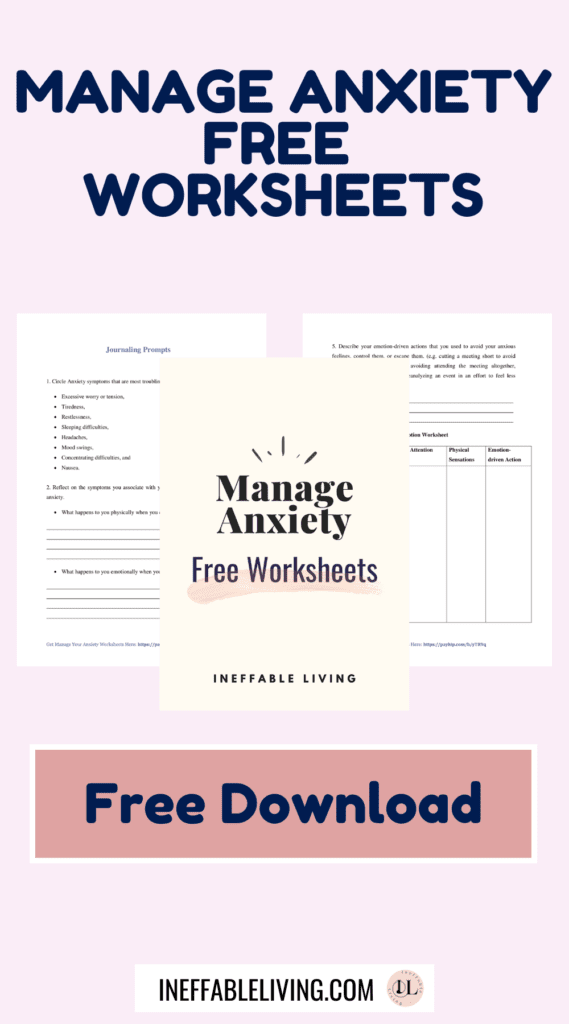
FAQ
Is Anxiety Curable?
Some people believe that anxiety is curable, while others believe it’s only manageable.
The fact is, anxiety serves a purpose: it’s our body’s way of giving us a boost when we are in danger or when we need to focus. So it is not something we want to eliminate completely.
Anxiety could be compared to physical pain. While physical pain can cause great discomfort, it’s just a symptom. The real issue isn’t the physical pain, but what causes it.
Similarly, anxious symptoms are a sign that we need to address whatever is triggering that anxiety, be it certain situations, or unhelpful thinking patterns. In that sense, anxiety disorders can be curable.
How Often Should I See A Therapist For Anxiety?
If you’re contemplating the idea of seeing a therapist for anxiety, then you likely have lots of questions. One of them might be, “How often should I see a therapist?”
Typically, it’s once per week when beginning therapy. Then, you may increase or decrease the frequency of your sessions as needed.
Keep in mind that there are no rules when it comes to how often you should see a therapist for anxiety or any other issue.
How often you need to see a therapist would depend on a number of factors, including the severity of the condition, personal events happening in your life, the type of therapy, etc.
For instance, cognitive-behavioral therapy is one of the most common types of therapy for anxiety. Sessions are usually weekly and last about forty-five minutes or fifty minutes.
In general, you’ll know how often you should see a therapist for anxiety after your first appointment. The therapist would use assessment and screening tools to determine your needs and how often should you see each other.
How Long Do I Need to Stay in Therapy?
There is no right answer here since the length of therapy would depend on a number of factors, including the status of personal progress, emotional resilience, support outside of therapy, life experiences, etc.
However, one study found that twelve to sixteen sessions are enough for the average person to experience positive change in their life.

References
- Portions of this article were adapted from the book The Anxiety Encyclopedia: Your Path to Recovery, © 2021 by Jotham Sadan. All rights reserved.
- High functioning anxiety: Definition, symptoms, signs, and more (medicalnewstoday.com)
- High-Functioning Anxiety: Symptoms And Treatment – Forbes Health
- The Characteristics of High Functioning Anxiety (verywellmind.com)
- The impact of anxiety upon cognition: perspectives from human threat of shock studies – PMC (nih.gov)
- High-Functioning Anxiety – Bridges to Recovery
- Seeing Through the Cloud of High-Functioning Anxiety (psychcentral.com)
- 6 Ways to Cope with High-Functioning Anxiety (healthline.com)
- Signs You Have High-Functioning Anxiety – Cleveland Clinic






